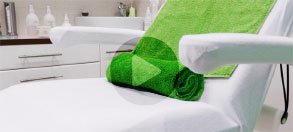
Keep Your Pet Groomed
Grooming your pet includes tasks such as trimming toenails, brushing fur, and trimming unkempt areas such as around the feet. While brushing is important for managing your pet’s fur, it is also an effective way to control shedding. Regular brushing enables you to remove the loose fur so your dog or cat does not deposit it around your house. For best results, designate a special location for grooming, such as outdoors, in the basement, or in the garage, away from carpets and upholstery. The frequency of grooming depends on your pet’s fur type. For example, dogs with smooth, short coats will not need more than weekly brushing. But dogs with long or dense coats, such as retrievers or collies, will need brushing two or three times each week. Some dogs, such as Yorkshire terriers, may need daily brushing to manage their coats. While cats tend to groom themselves more effectively than dogs, they also require regular brushing. Brush a short-haired cat weekly and a long-haired cat several times each week.
Hair-Proof Areas
The furnishings and decor you choose for your home can determine how you manage pet hair. For example, if you have wall-to-wall carpet in your house, your pet will likely shed throughout the rooms, necessitating frequent vacuuming to manage the hair loss. You can streamline hair removal by installing hard flooring such as hardwood or tile instead of carpeting and leather furniture instead of cloth upholstery. The hard flooring and leather upholstery will prevent pet dander from settling into carpet and cloth fibers. Another method for managing your pet’s shedding is to control your pet’s access to certain areas of your home. For example, if you want to ensure that fur does not cover the rug and furniture in your living room, install gates at doorways or train your pet not to enter this room.
Cover Surfaces
If your pet frequents specific areas of your home, such as a corner of the living room or a spot on the couch, you may notice that hair accumulates in these places. If you transport your pet in the car, you may see fur left behind on the car seats, too. You can control the mess by covering these surfaces with a towel or a small blanket. As your pet leaves fur behind on the covering, it’s a simple process to remove it and shake it off outdoors and then wash it in the washing machine. The surface underneath the towel or blanket will remain free of hair.
Vacuum
Vacuuming is an effective way to manage excess pet fur. The benefits of vacuuming go beyond just hair removal, though. When you vacuum surfaces, you also remove pet dander that can be an allergen for some people. Vacuuming is also important for removing pests such as carpet beetles that may infest a carpet littered with pet hair. Carpet beetles feed on fibers such as animal fur and carpeting, possibly leading to carpet damage. Regular vacuuming should control the presence of carpet beetles in a home.
The vacuum you use is also important for hair removal. Look for a model with special pet-grade motorized brushes and attachments that will enable you to clean effectively. Most pet-grade vacuum cleaners also feature HEPA filters for effective cleaning. HEPA filters have a special design that forces air through a fine weave, trapping dander and dust mites and preventing these particulates from re-entering your home. In this way, HEPA filters help reduce allergens in a home.
- How to Keep Pet Hair to a Minimum in Your Home
- Carpet Beetles
- Creating an Asthma-Safe Home
- Easy Tips to Prevent and Control your Allergy
- Spring Cleaning With an IPM Eye
- Cleaning Tips
- Pet Allergy Management
- Managing House Dust Mites
- Fact Sheet: Carpet Beetles
- The Best Upholstery Fabric for Pet Owners
- Housekeeping 101
- Vacuuming the Carpets
- Help for the Unhealthy House
- Equipment Selection, Use, and Maintenance
- Grooming FAQ
- Grooming Your Pet Reduces Shedding and Allergies


